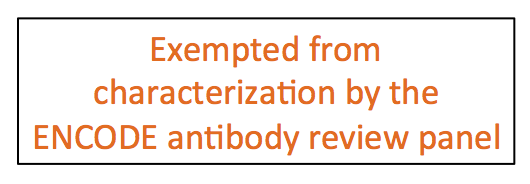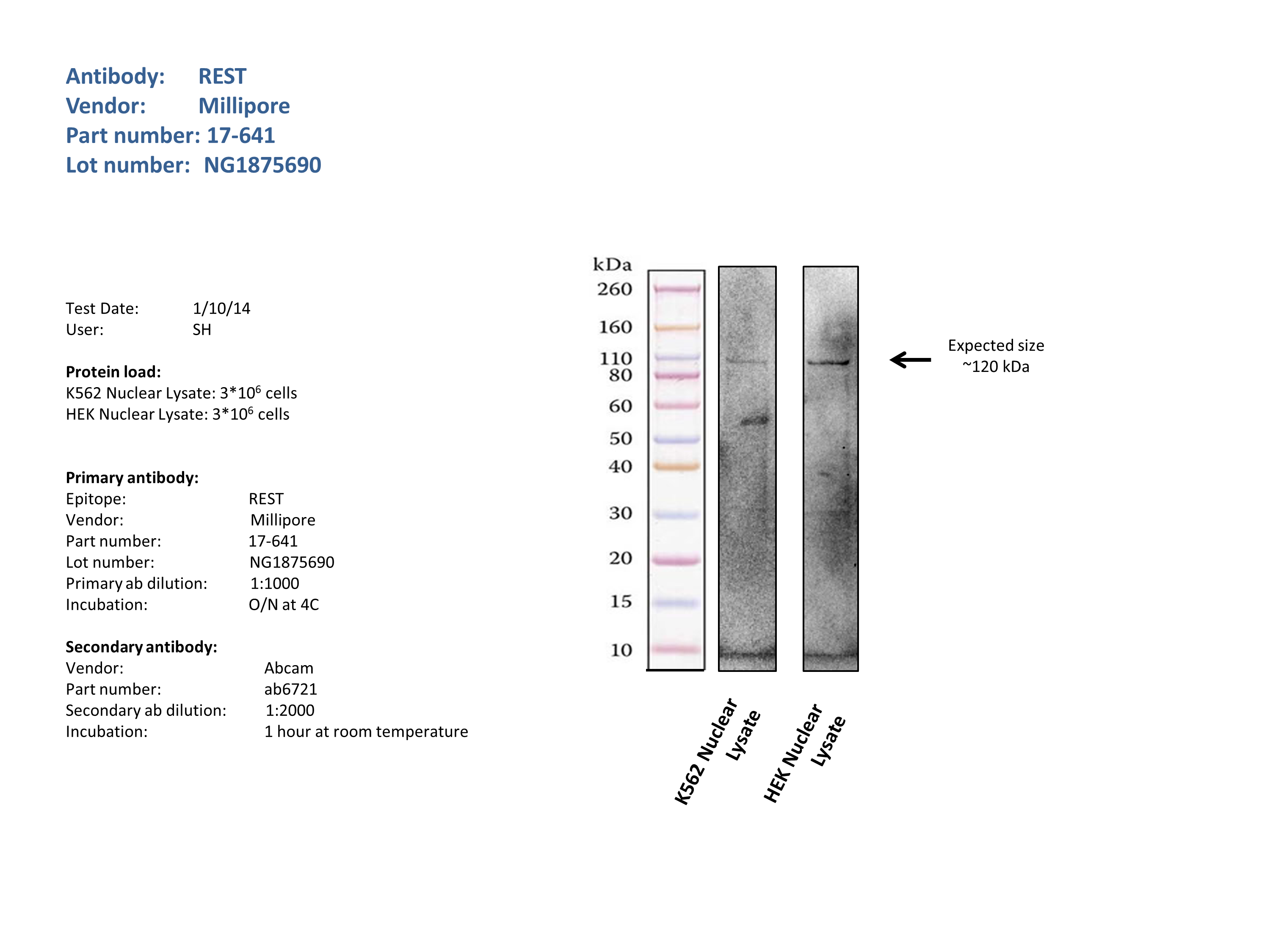ENCAB334JUA
Antibody against Homo sapiens REST
Homo sapiens
K562, HEK293, H1
characterized to standards with exemption
- Status
- released
- Source (vendor)
- Millipore
- Product ID
- 17-641
- Lot ID
- NG1875690
- Characterized targets
- REST (Homo sapiens)
- Host
- rabbit
- Clonality
- polyclonal
- Antigen description
- RE1-silencing transcription factor
- Aliases
- bradley-bernstein:PchAb 717
- External resources
Characterizations
REST (Homo sapiens)
H1
exempt from standards
- Submitter comment
- Situation: A single experiment (already released with a badge) used this antibody, here. The two replicates of the experiment used different antibody lots. One antibody lot (here Millipore 17-641 lot 2384024) was released without any badge. In contrast, this antibody (Millipore 17-641 Lot NG1875690) was released with a badge requiring a secondary validation. We are requesting (a) exception from primary validation in this cell type (H1-hESC) since we did a western in two other cell types (K562 and HEK293). Also, we are requesting (b) review of the secondary validation submitted, based on motif enrichment analysis, and currently on the DCC web portal as "review in progress". Note, a similar secondary antibody validation document was also supplied for two other REST antibodies and was already deemed "characterized to standard with exemption" in both cases.
- Reviewer comment
- PJF: I think that the REST Millipore 17-641 Lot: NG1875690 antibody should receive a “characterized to standard with exemption” .
- Submitted by
- Nina Farrell
- Lab
- Bradley Bernstein, Broad
- Grant
- U54HG006991
- Download
- exempted.png
REST (Homo sapiens)
Method: ChIP-seq comparison
exempt from standards
- Caption
- REST is a sequence specific binding factor. As such, the validation standard for REST antibodies is distinct from the chromatin regulator validation standard under which the remainder of our antibody validation dossiers are being constructed. The present document does not intend to substitute for the full computational analysis for the enrichment of the recognition sequence for REST in peaks discovered using ChIP-seq. The present document will merely illustrate the tracks we have obtained using two distinct lots of a particular antibody, and will present a single illustration of the occurrence of a perfect occurrence of the REST recognition sequence in tight proximity to a ChIP-seq peak, using a particular locus [CHRNB2 (cholinergic receptor nicotinic beta 2 subunit)] identified in the classic literature on the genome-wide occurrence of the recognition motif of the neuron-restrictive silencing factor (REST). Many thousands of other such illustrations could also be presented.
- Submitter comment
- A single experiment (already released with a badge) used this antibody, here. The two replicates of the experiment used different antibody lots. One antibody lot (here Millipore 17-641 lot 2384024) was released without any badge. In contrast, this antibody (Millipore 17-641 Lot NG1875690) was released with a badge requiring a secondary validation. We are requesting (a) exception from primary validation in this cell type (H1-hESC) since we did a western in two other cell types (K562 and HEK293). Also, we are requesting (b) review of the secondary validation submitted, based on motif enrichment analysis, and currently on the DCC web portal as "review in progress". Note, a similar secondary antibody validation document was also supplied for two other REST antibodies and was already deemed "characterized to standard with exemption" in both cases.
- Reviewer comment
- PJF: I think that the REST Millipore 17-641 Lot: NG1875690 antibody should receive a “characterized to standard with exemption”.
- Submitted by
- Nina Farrell
- Lab
- Bradley Bernstein, Broad
- Grant
- U54HG006991
- Download
- REST PchAb 717 SAV.pdf
REST (Homo sapiens)
K562HEK293
compliant
- Caption
- 3X10e6 cells equivalent of nuclear extract from HEK293 and K562 cells, were resolved by electrophoresis on a 4-12% acrylamide gel. After separation, the samples were transferred to a nitrocellulose membrane with an Invitrogen iBlot system. Membrane was blocked for an hour in room temperature, with 5% nonfat dry milk and blotted with primary antibody in the appropriate concentration over night at 4c. Membrane was washed and blotted with secondary HRP-conjugated antibody. Detection was made with Optiblot ECL Detect Kit (ab133406) for 2 min. a single band of the expected size was detected (~120kDa).
- Submitted by
- Noam Shoresh
- Lab
- Bradley Bernstein, Broad
- Grant
- U54HG006991

